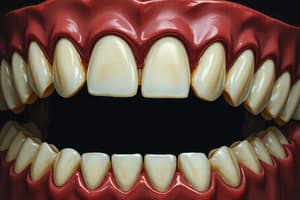Podcast
Questions and Answers
What is the main purpose of the minor connector in a removable partial denture (RPD)?
What is the main purpose of the minor connector in a removable partial denture (RPD)?
- To serve as the primary support structure
- To provide rigidity and stability (correct)
- To enhance comfort during wear
- To act as a flexible joint between components
How thick should the metal be at the rest to truss arm junction when using gold?
How thick should the metal be at the rest to truss arm junction when using gold?
- 3.0 mm
- 1.5 mm
- 1.0 mm
- 2.0 mm (correct)
What function does the proximal plate serve in a removable partial denture?
What function does the proximal plate serve in a removable partial denture?
- To create a flexible connection with the major connector
- To guide the denture during insertion and withdrawal (correct)
- To reduce the weight of the denture
- To provide cushioning during insertion
Which of the following statements is true regarding the ridge mesh in a removable partial denture?
Which of the following statements is true regarding the ridge mesh in a removable partial denture?
What is required when the proximal plate crosses gingival tissues?
What is required when the proximal plate crosses gingival tissues?
What is the primary purpose of the Tissue Stop in denture frameworks?
What is the primary purpose of the Tissue Stop in denture frameworks?
Where is the usual location of the finishing line in a denture framework?
Where is the usual location of the finishing line in a denture framework?
What is one design specification required for the mesh in a dental framework?
What is one design specification required for the mesh in a dental framework?
What angle should the finishing line form at the junction with the major connector?
What angle should the finishing line form at the junction with the major connector?
How is the size of the maxillary ridge mesh defined compared to the mandibular ridge mesh?
How is the size of the maxillary ridge mesh defined compared to the mandibular ridge mesh?
Flashcards are hidden until you start studying
Study Notes
Minor Connector in RPD
- A minor connector is a rigid component that connects the major connector or base of a partial denture to other components such as direct retainers, indirect retainers, and the denture base.
Functions of Minor Connector
- Provides unification and rigidity to the partial denture structure.
- Distributes stress evenly across the denture framework.
- Offers bracing by maintaining contact with guiding planes.
- Maintains the correct path of insertion for the denture.
Components of Minor Connector
- Truss Arm: Connects the major connector to other parts; thickness at the junction with the rest is 1.5mm for base metal alloys and 2.0mm for gold.
- Proximal Plate:
- Contacts the proximal surface of teeth and acts as a guiding mechanism during insertion and withdrawal.
- Positioned slightly lingually to enhance rigidity, reciprocation, and esthetics.
- Minimal gingival coverage is preferred with required relief when crossing gingival tissues.
- Cannot utilize undercuts without pre-blocking.
Ridge Mesh
- Serves as the area where denture bases attach, acting as "retentive struts for acrylic resin."
- Types of ridge mesh include open lattice, mesh, posts, and tissue stops.
- Maxillary ridge mesh covers the entire ridge, while mandibular mesh covers up to two-thirds of the ridge.
Tissue Stop
- Also known as Stop Button or Metal Stop, it's a small metal projection in the base that prevents downward movement of the plastic area during resin packing.
- Provides stability during transfer and processing, preventing distortion of the framework.
Finishing Lines
- The line at the junction of the major connector and mesh work should maintain an angle of no greater than 90 degrees for optimal fit and natural palatal shape.
- Both external (for wax pattern) and internal (for tissue side) finish lines need to be established during the manufacturing process.
Design Specifications
- Minor connectors should possess sufficient thickness for rigidity, ensuring effective force transmission among linked components.
- High polish is necessary to minimize plaque accumulation.
- Should be positioned at least 5mm away from other vertical components to maintain structural integrity.
Studying That Suits You
Use AI to generate personalized quizzes and flashcards to suit your learning preferences.




